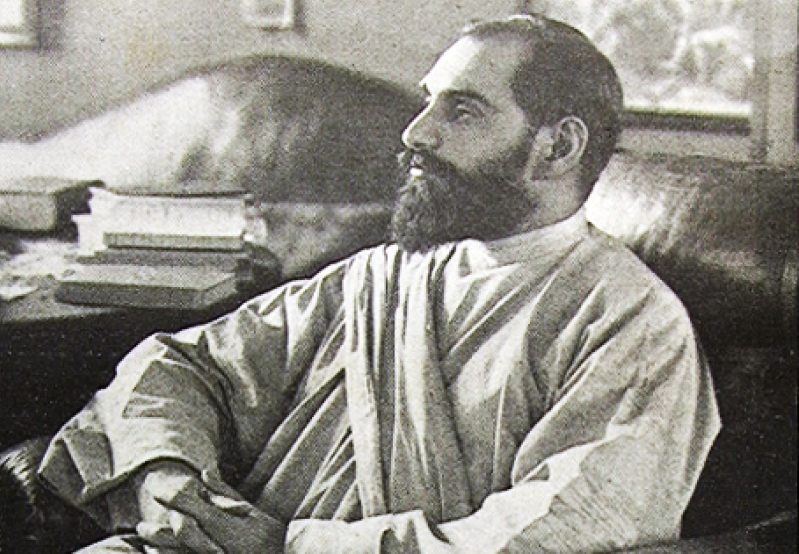
Sadhu Sundar Singh, the barefoot Indian evangelist remembered for bridging Indian spirituality and Christian discipleship, continues to speak relevantly to the global Church nearly a century after his death. That was the central message of a two-day international webinar where scholars and church leaders from different parts of the world revisited his theological legacy and what it offers to Christians today.
The online gathering, held Sept. 5–6 and organized by the Sadhu Sundar Singh Global Forum in collaboration with the Evangelical Fellowship of India, the National Council of Churches, Caleb Institute, Asia Church Missionary Society and Church History Association of India, drew participants from across India, Asia, Europe and Africa.
It was the second international webinar following the first gathering in 2022 whose proceedings were published as No Turning Back: Reflections on Mission, Theology and Spirituality of Sadhu Sundar Singh, edited by Vinod Victor and Samuel Richmond Saxena and published by ISPCK and Asia CMS.
Presenters emphasized that Singh’s life resists easy categorization. He was a mystic who claimed visions of Christ and angels yet did not stray from Scripture, an ascetic who renounced possessions yet traveled the world, a contextual theologian who clothed the gospel in Indian forms without diluting its content.
Singh’s life, they agreed, remains strikingly relevant at a time when churches worldwide are struggling with consumerism, interfaith tensions, ecological crisis, and questions of authenticity. His ascetic lifestyle, interfaith engagement and Christ-centered devotion were offered not as curiosities of the past but as living challenges for today’s Church.
Born in 1889 into a Sikh family in Punjab, Singh experienced a vision of Christ at age 16 that changed the course of his life. Rejecting both the wealth of his family and the trappings of Western Christianity, he adopted the saffron robes of a sadhu, traveling barefoot across India and into Tibet. He often disappeared for weeks into the Himalayas to pray, returning with parables and visions that combined biblical imagery with the rhythms of Indian storytelling. His writings were translated into multiple languages, making him a well-known figure in Britain and continental Europe after his travels there in the early 1920s. He vanished in 1929 during a journey toward Tibet, but his memory remains alive through stories, devotional writings and the communities he influenced.
The webinar began by situating Singh in his context — a man of Punjab, deeply formed by Sikh and Hindu traditions, who believed Christianity could be authentically Indian. “Indians do not want doctrine. We are tired of doctrines. We need the living Christ,” Singh once said, a line that surfaced repeatedly across presentations. For participants, this statement crystallized his role: he was not a theologian of systems but of life, and he insisted that Christ could be known in ways that resonated with Indian culture.
Contextual discipleship and authenticity
Much of the discussion focused on Singh’s example of contextual discipleship. He believed that Indian Christians should not abandon their cultural identity but should follow Christ in ways that felt familiar to their people. His choice to live as a sadhu was not an imitation of Hindu ascetics but an assertion that Christian discipleship could take an Indian form.
This conviction remains a challenge today, especially in societies where Christianity is still seen as foreign. Speakers stressed that Singh’s life demonstrates how contextualization strengthens rather than weakens the witness of the Church. His radical simplicity, his refusal of possessions, and his hospitable lifestyle were described as a critique not only of colonial patterns but also of the prosperity gospel and consumerist culture. “His life is a challenge to prosperity preaching today,” one participant observed.
At the same time, scholars were careful not to idealize him. Several pointed out that Singh did not directly address issues of caste oppression or gender injustice. One presenter warned, “Spirituality without justice risks becoming escapist.” The challenge, they said, is to extend Singh’s Christ-centered devotion into engagement with structural issues that shape societies today. In this way, his witness can be complemented by a stronger prophetic voice.
Singh’s ministry also underscores the power of storytelling and embodied faith. His parables often drew from village life and nature, making the gospel accessible without abstraction. His stories, still remembered in Punjab, illustrate how a faith communicated in familiar forms can remain both faithful and transformative.
Mysticism that leads to mission
Another theme was Singh’s mystical spirituality. Accounts of his visions — of Christ, angels and the heavenly realm — made him famous, and in some circles controversial. Yet presenters argued that Singh’s mysticism was never escapist. Rather, it was the wellspring of his mission. “He prayed in caves but returned to villages with love,” one speaker said, highlighting the integration of contemplation and service.
His long retreats in the Himalayas, often in silence and solitude, produced experiences that he interpreted through the lens of Scripture. He did not present them as alternatives to the Bible but as confirmations of it. His writings, such as Visions of the Spiritual World, presented a Christ-centered mysticism that resonated far beyond India.
Contemporary scholars drew creative parallels between Singh’s mystical experiences and modern psychology. One paper compared his spiritual life to Abraham Maslow’s hierarchy of needs, suggesting that Singh embodied both personal wholeness and deep communion with God. This, the presenter argued, illustrates that mature spirituality integrates emotional health with devotion, a balance needed in churches today where spirituality can become fragmented.
Singh’s example pushes back against two distortions: a spirituality that retreats from the world and a mission that forgets prayer. His life combined both, showing that intimacy with Christ fuels engagement with society.
The cross and the cost of discipleship
Speakers also revisited Singh’s theology of suffering. His barefoot journeys through rough terrain, rejection by family, and exposure to persecution shaped a vision of discipleship marked by endurance. He understood suffering not as failure but as the path of the cross.
Several papers emphasized this “cross-shaped” life as a corrective to triumphalist or consumerist Christianity. Singh’s willingness to be vulnerable, to live without protection or wealth, and to face rejection was contrasted with modern approaches that equate faith with success. One scholar suggested that Singh’s example is especially relevant to younger generations searching for authenticity: “His life shows that meaning is not found in comfort but in faithfulness.”
Singh’s perspective also resonates with persecuted Christians in India and elsewhere. By accepting suffering as integral to witness, he offered a framework for endurance that avoids despair. His joy amid hardship continues to encourage believers facing pressure for their faith.
Authority, Scripture and the “water of life”
The role of authority in mystical traditions was another subject of debate. Singh valued visions, but he insisted that the Bible remained the final measure. He described Christ as the “water of life,” a phrase that appeared often in the webinar, and argued that any true mystical experience must flow from and point back to him.
This balance was described as the key to Singh’s credibility. Unlike some mystics who present their visions as independent authority, Singh rooted everything in Christ and Scripture. “He combined Indian mystical thought with the water of life theology of Christ,” one paper explained. For a church today navigating a range of spiritual expressions, his example offers a model: openness to experience, but anchored in biblical witness.
Participants suggested that this has global implications. In pluralistic societies where spirituality is often privatized or detached from tradition, Singh’s Christ-centered mysticism shows how experience can be both authentic and accountable.
Nature as God’s first book
Ecological spirituality also received significant attention. Singh frequently used images from nature in his teaching — rivers, birds, mountains, flowers — not merely as illustrations but as theological truths. He saw creation as God’s “first book,” a testimony alongside Scripture.
One paper argued that Singh lived an ecological discipleship before the term existed. His ascetic lifestyle, owning little more than a robe, staff and New Testament, was described as a critique of materialism and a model of sustainable living. His reverence for nature reflected an awareness that creation participates in God’s purposes.
In the era of climate change, presenters suggested, Singh’s ecological spirituality offers resources for the church. It reminds Christians that care for creation is not optional but integral to discipleship. His life provides an example of simplicity and reverence that could inspire ecological practices in churches today.
Bhakti devotion and Indian roots
Finally, the webinar examined Singh’s place within Indian devotional traditions. His prayers, poetry and visions reflected the ethos of bhakti, the devotional movements within Hinduism and Sikhism that emphasize love for God. Singh reoriented this ethos toward Christ, demonstrating continuity between Indian spirituality and Christian discipleship.
By adopting familiar language and forms, Singh showed that the gospel was not foreign but fulfilled India’s spiritual longings. He often said the water of life had been offered in a “Western vessel” when it should be presented in an “Eastern bowl.” For scholars and pastors, this continues to challenge how churches think about contextual theology in their own settings.
Speakers concluded that Singh’s witness carries lessons not just for India but for the entire world. His simplicity critiques consumerism. His cross-shaped discipleship challenges comfortable Christianity. His mysticism offers depth without detachment. His ecological vision speaks to today’s environmental crisis. And his devotion shows how faith can be authentically rooted in local cultures without losing universal truth.
One participant summarized: “Singh was mystical yet missional, contextual yet universal, personal yet prophetic.”
The webinar served as a reaffirmation that nearly a century after he disappeared into the Himalayas, Singh remains a relevant voice of modern Christianity. His life continues to remind the Church that the gospel is not primarily a doctrine to be defended but a life to be lived — authentically, simply, and in communion with Christ.
The following distinguished group of church leaders, scholars, and practitioners spoke at the two-day webinar: Inaugural Address was given by The Most Rev. P. K. Samantaroy and with greetings from Rev. Vijayesh Lal, Rev. Dr. Shivraj K. Mahendra, Rev. Dr. Chan Nam Chen, Rev. Dr. Richard Howell, Rev. Jyoti Singh, The Rt. Rev. Kaleem John and Archbishop Rowan Williams (via video). Pastor Joseph Masih shared the vision of the Sadhu Sundar Singh Global Forum. Keynote speaker Rev. Raymond Larsen set the tone for sessions moderated by Rev. Rana Khan, Rev. Dr. Samuel Richmond, Rev. Sijo John, Rev. Prateek Pillai, Rev. Albert Lalramzau, and Rev. Dr. Sunil Caleb. Presenters included Mrs. Samarpita Patra, Dr. Pulak Samantaroy, Ms. Rijul Zoe Alfred, Rev. Dr. Richard Howell, Rev. Ashish Archer, Mr. Ranjit Chaudhary, Ms. Gadda Divya, Dr. Jai Knox, Dr. Binod Peter Senapati, Rev. Amos Messey, Ms. Anugrah Brij, Mr. Jitender Jeet Singh, Dr. Jeevaraj Anthony, Rev. Ram Pal, and Dr. Ivan Satyavrata. The event concluded with a closing address by Rev. Dr. Michael Biehl, reflections from Pastor Joseph Masih, and a vote of thanks by Rev. Dr. Vinod Victor. Prayers were offered by Dr. Limasangla Lemtur, Bishop Patrick Augustine.





